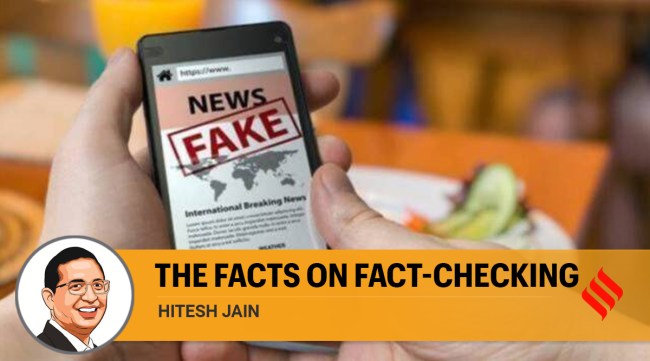Opinion Criticism of government’s attempt to combat fake news is premature and misguided
While the rules continue to be debated, online and in court, one must keep in mind that over 80 million Indian citizens are online. This fact, coupled with the perils of false information, leads to a worrying cocktail that the government has to proactively tackle to prevent chaos
 In the last half-decade, governments across the world have begun to recognise the threat posed by fake or false information, especially on digital platforms. More than ever before, authorities began to realise the hazards of fake information during the Covid-19 crisis. (Express Photo)
In the last half-decade, governments across the world have begun to recognise the threat posed by fake or false information, especially on digital platforms. More than ever before, authorities began to realise the hazards of fake information during the Covid-19 crisis. (Express Photo) On April 6, MeitY announced the IT (Intermediary Guidelines and Digital Media Ethics Code) Amendment Rules, 2023. The rules, amongst other anticipated provisions, introduce “fact-checking units” to tackle the menace of fake news. These fact-check units have been tasked with the duty of identifying false, fake or misleading information pertaining to the central government’s business. Interestingly, the IT Amendment Rules, 2021 had previously introduced provisions to tackle information “which is patently false or misleading in nature but may reasonably be perceived as a fact”. Therefore, by introducing a provision for notifying a fact-check unit, the new rules have created regulations that further insulate social media users from misleading content.
In the last half-decade, governments across the world have begun to recognise the threat posed by fake or false information, especially on digital platforms. More than ever before, authorities began to realise the hazards of fake information during the Covid-19 crisis. The pace at which false information began to spread was unprecedented. Eventually, governments realised that the dangers of fake or misleading news are in their ability to spread like wildfire on social media. Scholars at the Massachusetts Institute of Technology even found that falsified content spreads six times faster than factual content on online platforms. What this effectively means is that people are more likely to spread fake and misleading news than verified truthful information. Upon realising the reach of falsified news, governments have begun to take concrete steps, such as creating task forces (in Australia, Canada and Denmark) and laws (in France and Germany).
So as to fully understand the gravity of the issue that we are grappling with, reflection on past instances of the spread of government-related fake news is needed. A study conducted by the International Federation of Library Associations and Institutions found that India was a hot-bed for Covid-related fake news. Such misleading information ranged from the vaccine drive to the symptoms and aftermath of the virus itself. It is thus unsurprising that an absurd falsified claim that all vaccinated persons will die within two years was being aggressively shared and reshared by social media users in India.
As we enter the next sphere of the digital realm, it is becoming doubly important for governments to prepare themselves for the dangerous interplay of fake news and AI-related technologies such as deepfakes. For instance, imagine a viral deepfake (a digital manipulation used to create fictitious persons or fictitious videos of persons) of the Prime Minister making misleading statements about government schemes, policies or even communities and groups. Although it might sound far-fetched, the use of deepfakes to spread disinformation is already a reality. In February this year, deepfakes of purported news anchors praising China’s role in geopolitical relations were spread across accounts on Twitter and Facebook by pro-China accounts. Deepfakes of the Ukrainian President Volodymyr Zelenskyy announcing a surrender were also circulated across platforms last year. This convincing ability of deepfakes, and connectedly, the inability of people to separate them from truthful content, is what makes them prone to being used to spread false information.
Against this background, the government’s announcement of the new rules shows foresight. It is not hard to envisage the detrimental impact that falsified information has on the government’s ability to manage emergencies; for instance, carrying out essential vaccination initiatives. Any roadblock in the easy and quick implementation of such initiatives could be life-threatening. Further, such falsified information is rarely ever positive, since its very purpose is to create a state of alarm amongst the public. This can have dangerous law and order consequences and lead to pandemonium. However, compulsive contrarians have raised their usual objections, vociferously arguing that the rules have a “chilling effect” on the public. This criticism is wholly unsubstantiated considering that the fact-checking units, which form the fulcrum of the rules, are still to be notified by the government. Even the Bombay High Court, whilst hearing a challenge to the rules, orally remarked that at this stage they are presently “inoperable or sterile” owing to the non-notification of the fact-checking units. It is only upon the notification of the units that further nuances will be discerned. Thus, any arguments against the rules right now would be premature, if not illusory. Critics would do well to, if not understand the legitimate intent behind the rules, at least hold off tired objections until the fact-checking units are notified.
While the rules continue to be debated, online and in court, one must keep in mind that over 80 million Indian citizens are online. This fact, coupled with the perils of false information, leads to a worrying cocktail that the government has to proactively tackle to prevent chaos. Although the trend of compulsive contrarians continues, it seems that in introducing these rules the government has caught onto the macro perspective, the one that Jonathan Swift warned us of in his essay in 1710, “Falsehood flies, and the truth comes limping after”.
The writer is vice president, BJP Mumbai Pradesh and Managing Partner, Parinam Law Associates





